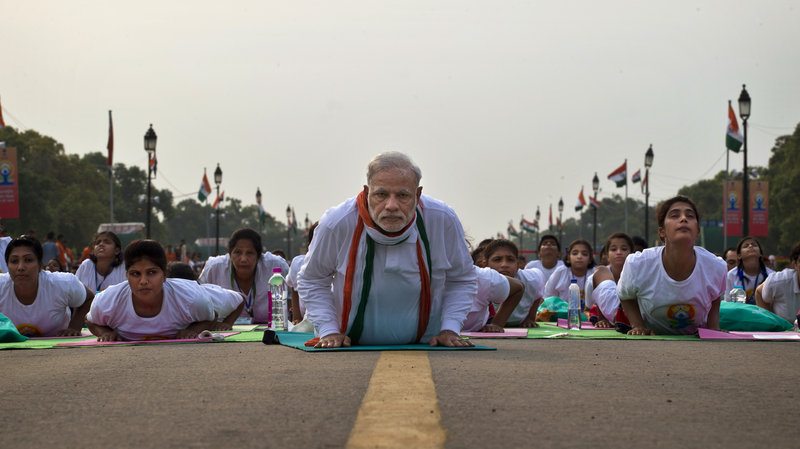
Meet the Yogi of Rajpath
Who would have imagined a Prime Minister of India lying in the middle of the road (the yellow traffic line is visible) on a yoga mat doing yoga asanas with the aam janta, an image which would be flashed across the world for all to see?
Where other leaders in his place may have just made lofty speeches or inaugurated events, PM Narendra Modi sat down cross-legged and actually did what all the citizens of India were doing and kept up with all 35,985 of them. There was no self-consciousness or hesitation, just a passion to pass on the benefits of yoga to everyone.
There will always be lots of controversy, lots of opinions about why the Modi Government promoted International Yoga Day but there can be no two views about its value around the world. It was exhilarating to see thousands gathering together in New Delhi to exercise their minds and bodies – such crowds have only been seen before at cricket matches and Bollywood concerts – both bystander sports where you watch others being active.
By making International Yoga Day interactive and fun – Modi has got the support and interest of the youth of India. After all, which teenager would not like to break a Guinness World Record? Now the challenge is to keep the yoga power alive, and make it a part of daily living.
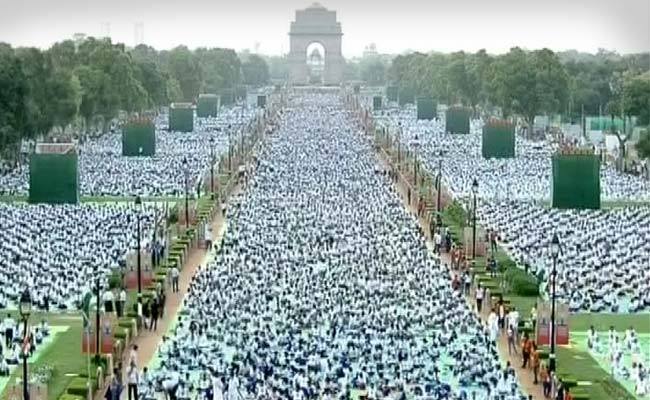
Here are Modi’s remarks at the International Conference on Yoga for Holistic Health.
‘The Community of Nations Responded as One’
Today we are celebrating the first International Day of Yoga. When I spoke at the United Nations General Assembly on 27 September, 2014, urging the world community to adopt an international day of yoga, little did I know the kind of unprecedented response our proposal would receive.
The community of nations responded as one. On December 11, 2014 the 193-member United Nations General Assembly approved the proposal by consensus with a record 177 co-sponsoring countries.
As I stand here today the International Day of Yoga is being celebrated across the world.
Millions of people around the world are participating in this event. From sunrise in the Far East to sunset in the furthest corner of the western hemisphere, people will join in this great celebration of yoga today.
In India, this morning, millions of people participated in a simple yoga demonstration at Rajpath, in states and district capitals, in community groups and in their homes also. This solidarity in yoga, this coming together with our brothers and sisters in other countries, brings our hearts and minds closer. I am also happy to release here today a commemorate coin and postal stamp on the occasion.
I am grateful to the international community for the support. I acknowledge with all humility that this support is not just for India. This support is for the great tradition of yoga, the tradition that helps individuals and societies to discover a sense of oneness with the self, with each other and nature.
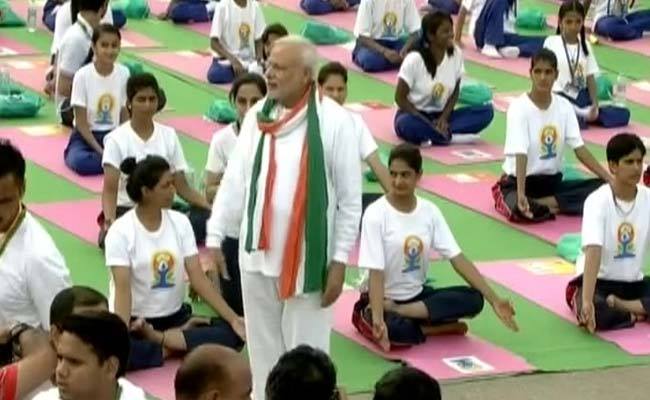
Who is a Yogi?
The reach and spread of yoga spans continents, cuts across differences of colour, class and creed. I am told that there are communities of yoga practitioners in almost every country in the world.
From the banks of the river Indus to every continent in the world yoga has spread harmony between man and nature and a holistic approach to health and well-being.
It is said that yoga transforms lives. In order to benefit fully from yoga, to understand yoga in its entirety, we must understand who is a yogi.
A yogi is a person who is in harmony – with herself, her body, with her surroundings, with nature. Yoga is the means to achieve that harmony.
From the Upanishads, comes the idea of Yoga to transform human consciousness through control of body and senses through constant practice. The body is the vehicle for the realization of the Supreme Being.
The Bhagvad Gita – the song of the world – is a call to action and defines itself as a योगशास्त्र . The Gita says “योग कर्मेषु कौशलम्” – that is, yoga is excellence at work. Work with devotion and without attachment is yoga.
The Gita also says “योगस्य तथा कुरू कर्माणी” – act with the discernment of a yogi.
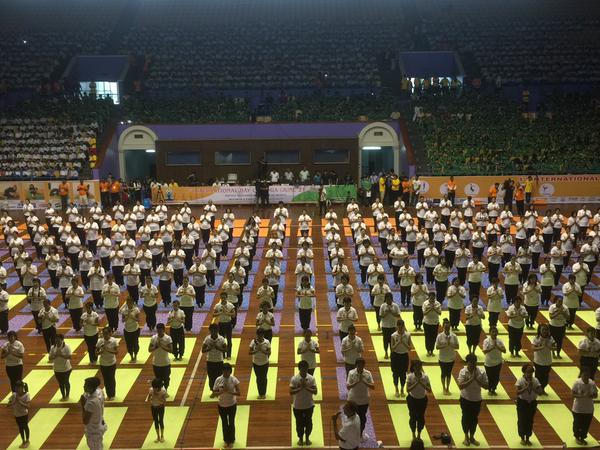
Yoga – Humanity’s Future
Yoga is, therefore, a vision for a harmonious future for humanity.
People often think that yoga is just a set of exercises. Yoga is a philosophy of discipline and meditation that transforms the spirit and makes the individual a better person in thought, action, knowledge and devotion.
The problems of modern lifestyles are well known. People suffer from stress related ailments, lifestyle related diseases like diabetes and hyper-tension. We have found ways to control communicable diseases, but the burden of disease is shifting to non-communicable diseases. Young people who are not at peace with themselves seek refuge in drugs and alcohol. There is ample evidence that practicing yoga helps combat stress and chronic conditions. If the body is a temple of the mind, yoga creates a beautiful temple.
The benefits of yoga are manifold. When practised correctly and with discipline, Yoga leads to:
Perfection of our body’s potential in strength, skill, and general well-being, peaceful and stress-free living. Control and mastery of our life-energies (प्राण) leading to health, long and disease-free life, capacity for full enjoyment of life.
Opening and refining of the heart’s emotions leading to greater compassion, mutual understanding, and sensitivity to the needs of others.
Full development of our mental powers, leading to heightened concentration, intelligence, creativity, intuition.
Liberation of our spirit from ignorance, suffering, incapacity, leading to freedom, equality, constant joyfulness and inner strength to overcome all challenges of life. It awakens the deeper sense of unity and oneness with the whole Universe and all living beings.
Together, these lead to the realisation of our highest divine Perfection.
The Evolution of the Individual
At a community level, the evolution of the individual through yoga results in:
Reduction of greed, coarseness and violence in thought and action.
Enormous reduction in the cost of healthcare and social support.
A dramatic reduction in conflicts and misunderstandings within families, communities, and between nations.
Increased collaboration and effective teamwork in businesses and communities
Compassion towards all beings: plants, animals and humans and long-term and ecological thinking in all socio-economic planning.
Increased power of innovation, technology and knowledge; deeper impact of art, music, poetry, dance to uplift the quality of life and an overall increase in the pace of human development and evolution.
To sum up, in a world of excess, of seeking after materialism, yoga promises restraint and balance. In a world suffering from mental stress, yoga promises calm. In a distracted world, yoga creates focus, creates concentration. In a world of fear, yoga promises strength and courage. A healthy body and a disciplined mind are the foundations of a world free from fear. In crafting a new self through Yoga, we create a new world.
We live in a world that is divided, in a world in conflict over material gains. A world in conflict over failures to understand each other. How shall we understand each other, if we do not understand ourselves?
Swami Vivekanand says in his book on Rajyoga – “Each soul is potentially divine. The goal is to manifest this Divinity within by controlling nature, external and internal. Do this either by work, or worship, or control, or philosophy – by one, or more, or all of these — and be free. This is the whole of religion. Doctrines, or dogmas, or rituals, or books, or temples, or forms, are but secondary details.”
It is this freedom that will free us from misunderstandings, from doubt, from conflict, and lead us towards world peace.
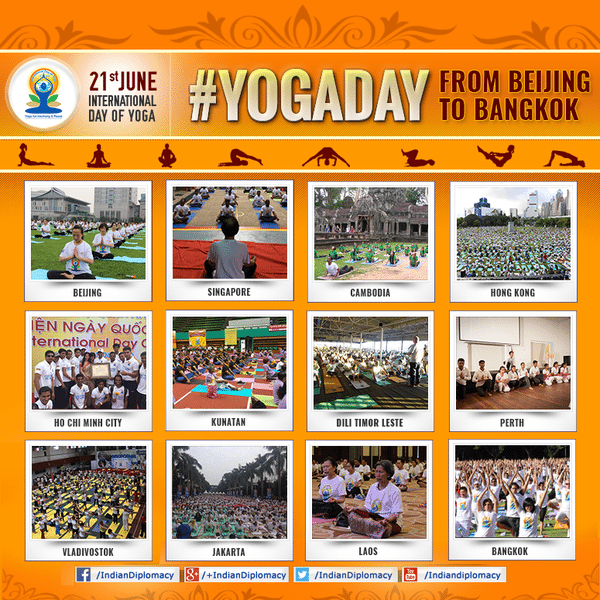
The Yogic Way for a Balanced Future
We are at a point in history, where global warming threatens the world as we know it. The world’s ecology is threatened by human greed and excess. Yoga shows the way to consumption that is healthy, balanced, and in tune with nature.
We will need to raise a generation that lives according to these principles if we want to leave the world habitable for future generations.
Sri Aurobindo said, “Indian Yoga is potentially one of these dynamic elements of the future life of humanity. it is now emerging from the secret schools and ascetic retreats in which it had taken refuge and is seeking its place in the future sum of living human powers and utilities.”
The spread of yoga, therefore, is the symbol of a changing world. In the past, yoga was the preserve of a select few saints. Today, it is available to all – in the words of Patanjali, “सार्वभौम” or a universal culture.
It represents a world where knowledge flows, without restriction of country, creed or class. It represents a world where people come together across boundaries, for causes and concerns that unite the planet.
The closest parallel I can think of is the movement to protect the environment, to protect the world that we live in.
As we work to make the benefits of yoga accessible to the whole world, we will also work to keep barriers to knowledge down, to ensure free flow of knowledge and information across boundaries. We will work to maintain an open world free of prejudice and discrimination.
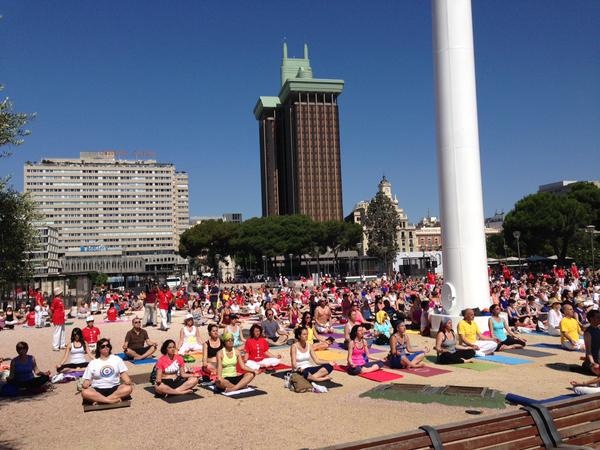
‘Yoga is our Collective Gift to Humanity’
I greet all my fellow practitioners in different countries who are present here in spirit. Yoga is our collective gift to humanity. It may have originated in India, but it draws its energies from the millions who practice it around the world. International Yoga Day is not the brainchild of a government or of the United Nations. It is a reflection of the largest knowledge based peoples’ movement the world has ever seen. A movement of people whose lives have been touched, been changed by yoga. We will take this movement forward to aim for better health, more fulfilled lives and more connected communities.
On this day, I also pledge the spirit of India, the collective energy of our people, to the creation of a more equal world, a world without fear, a world of peace. We will build on the foundations of the Indian spirit and its creative genius to reach out and foster a culture of inclusiveness, of fraternity, of one global family – वसुधैव कुटुम्बकम.
I will end with the grand invocation of good health and peace – the Shanti Paath,
Sarve Bhavantu Sukhinah
Sarve Santu Niramaya
Sarve Bhadrani Pasyantu
Ma Kascit Dukkha Bhagbhavet
May All Be Happy
May all be free from illness
May all see that which is auspicious
May no one suffer

2 Comments
32+ Via Google +
India Group
misterji loonker reshared
srihari.latha Srihari +1’d
vijaya kumar jami +1’d
srinivas seva +1’d and reshared
amit soni +1’d
Saravanan Saran 1993 +1’d
Hitesh Siyak29029 +1’d
Narasimha Murthy +1’d and commented
Govindapuram Kundukara commented
vikas sengar +1’d
kamal hasan +1’d
RAKESH BHALEKAR +1’d
Prithvi Singh Rabriyawas +1’d
raaj kumaar +1’d and reshared
shivasounds M +1’d
Bhanu shokeen +1’d
Tarashekhar Padhy +1’d
sri ram commented
kiran patel +1’d
sruthi kandukuri’s profile photo
sruthi kandukuri +1’d
Parveen Mehra +1’d
Pramod Rathod +1’d
prakash M +1’d
ganesh rathod +1’d
amitabh mishra +1’d
selvarasan selva +1’d
GANESH K. +1’d
Dilip Janani +1’d
Rajendra Kumar +1’d
saravanan murugan +1’d
Namita Verma +1’d
Mohan Kumar R +1’d
Kalam Kalam +1’d
Chetan Kandpal +1’d
Dinesh Sethumadhavan +1’d
Proud of our legacy, proud of our country, proud of our PM .